[1]
F. Klocke, D. Trauth, F. Schongen, A. Shirobokov, Analysis of friction between stainless steel sheets and machine hammer peened structured tool surfaces: experimental and numerical investigation of the lubricated interaction gap, WGP J. Production Engineering (2013).
DOI: 10.1007/s11740-013-0519-6
Google Scholar
[2]
E. Hartner, Verfahren zum Umformen eines flächigen Blechzuschnitts sowie zugehöriges Hausgerät, European patent application DE 10 2008 043 359 A1 (12. 05. 2010), BSH Bosch und Siemens Hausgeräte GmbH (2010).
Google Scholar
[3]
H. Gebauer, Verfahren zum Tiefziehen eines flächigen Blechzuschnitts mit einem Tiefziehwerkzeug, European patent application DE 10 2005 0236 158 A1 (23. 11. 2006), BSH Bosch und Siemens Hausgeräte GmbH (2006).
DOI: 10.1007/978-3-322-93425-3_12
Google Scholar
[4]
N. Bay, A. Azushima, P. Groche, I. Ishibashi, M. Merklein, M. Morishita, T. Nakamura, S. Schmid, M. Yoshida, Environmentally benign tribosystems for metal forming, CIRP Annals - Manufacturing Technology 59 (2) (2010) 760-780.
DOI: 10.1016/j.cirp.2010.05.007
Google Scholar
[5]
R. Wahl, Untersuchung des Einflusses von Mikrotexturierungen auf den einsinnigen, ölgeschmierten Gleitkontakt von Stahl/Saphir-Paarungen, KIT Scientific Publishing, Karlsruhe (2011).
Google Scholar
[6]
P. Groche, M. Steitz, Prozesskettenverkürzung im Werkzeugbau - Integration von Verfahren der maschinellen Oberflächeneinglättung, wt online 10, Düsseldorf (2011) 655-659.
DOI: 10.37544/1436-4980-2011-10-655
Google Scholar
[7]
F. Bleicher, C. Lechner, C. Habersohn, E. Kozeschnik, B. Adjassoho, H. Kaminski, Mechanism of surface modification using machine hammer peening technology, CIRP Annals - Manufacturing Technology 61(1) (2012) 375-378.
DOI: 10.1016/j.cirp.2012.03.139
Google Scholar
[8]
J. Wied, Oberflächenbehandlung von Umformwerkzeugen durch Festklopfen, PHD-Thesis TU Darmstadt (2011).
Google Scholar
[9]
F. Lienert, J. Hoffmeister, V. Schulze, Residual Stress Depth Distribution after Piezo Peening of Quenched and Tempered AISI 4140 - Proceedings of ICSR 9, Materials Science Forum (2013) 768-769.
DOI: 10.4028/www.scientific.net/msf.768-769.526
Google Scholar
[10]
D. Trauth, F. Klocke, F. Schongen, A. Shirobokov, Analyse und Modellierung der Schlagkraft beim elektro-dynamischen Festklopfen zur kraftbasierten Prozessauslegung, UTFScience III (2013).
DOI: 10.37544/1436-4980-2013-10-758
Google Scholar
[11]
F. Klocke, C. Kuwer, C. Zeppenfeld, Tribological Analysis of Diverse Ceramics in Contact with Stainless Steel under Different Lubricating Conditions, WGP J. Production Engineering, Annals of the German Academic Society for Production Engineering (2006).
Google Scholar
[12]
F. Klocke, D. Trauth, M. Terhorst, P. Mattfeld, Friction analysis of alternative tribosystems for a foil free forming of stainless steel using strip drawing test, accepted by WGP J. Production Engineering (June 2014).
DOI: 10.1007/s11740-014-0560-0
Google Scholar
[13]
M. Steitz, K. Weigel, M. Weber, J. Scheil, C. Müller, Coating of Deep Rolled and Hammer Peened Deep Drawing Tools, Advanced Materials Research 769 (2013) 245-252.
DOI: 10.4028/www.scientific.net/amr.769.245
Google Scholar


